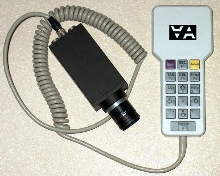Print Inspection Appliance offers stand-alone operation.
Share:
Press Release Summary:

PQEye(TM) smart camera-based instrument addresses narrow web print inspection tasks, checking position, correctness, and quality of text and graphics that are machine-printed on discrete parts. Operated using multifunction keypad and GUI, product can detect defects down to a few pixels in size on media moving at rates to 300 m/min. Inspection speeds range from 3 parts/sec on individual items to 20 frames/sec in web applications.
Original Press Release:
The Value Engineering Alliance Announces the PQEye(TM)
Stand-Alone Print Quality Inspection Appliance for High and Low End Applications
CAMBRIDGE, Mass- The Value Engineering Alliance, a leading provider of machine vision solutions, announces the addition of PQEye(TM), a stand-alone print quality inspection appliance. PQEye is a compact (50 x 50 x 170 mm, including lens), smart camera-based instrument that can be used to address narrow web print inspection tasks or check the position, correctness and quality of text and graphics that have been machine-printed on discrete parts. User-friendly and easy to integrate, the PQEye provides very appealing levels of price/performance and enables companies to routinely achieve rapid returns on their investments.
Completely PC-free, the PQEye's setup, training and test procedures are all done using its multifunction keypad and a graphical user interface that displays on standard SVGA monitors. Effectively inspecting the results of offset, flexographic, thermal transfer, laser, ink jet and other common printing processes, the PQEye is capable of addressing many of the applications which were previously the domains of PC-based vision systems and proprietary "big iron" boxes.
The PQEye's inspection software features an automated training procedure during which all typical print variations are taken into account. This results in the setting of sensitivity levels that enable the system to reliably detect defects only a few pixels in size on media moving at up to 300 meters/minute, while still clearly differentiating between normal print variations and unacceptable print flaws. Inspection speeds can range from around three parts per second on individual items up to 20 frames per second in web applications, depending on the capabilities of the smart camera serving as the system's implementation platform.
Typical high-end applications of the PQEye include: the inspection of pharmaceutical products, food and consumer goods labels, as well as integration into re-winders, cutting and slitting machines and high-speed bottle cap printing machines.
Typical low-end applications of the PQEye include: the inspection of pad or laser printed information on electronic components, keyboards, mobile phone and other kinds of keypads; printing and decorations on bottle caps; screenprinting on porcelain and glassware; lasermarked indicator/operator symbols on automobile dashboard panels; graphics and text marked on auto safety glass; pharmaceutical labels and cartons moving at slow speeds; and printing on medical equipment and dosing devices.
For additional information, visit http//www.The-V-E-A.com, email MarcelVEA@aol.com or call (617) 492-1252.
About The Value Engineering Alliance
Established in July of 1987, THE VALUE ENGINEERING ALLIANCE specializes in the conceptualization, development, marketing, selling, and implementation of machine vision solutions that lower the overall costs of laboratory and industrial manufacturing operations (analysis, assembly, inspection, test, control, identification, etc.) while achieving equivalent or enhanced levels of system/process performance and reliability.
Renowned as the supplier of application-specific vision software libraries used by several of the vision industry's premier players to enhance their existing offerings or expand into new application arenas, The VEA has been equally successful as a supplier of vision software and systems used in numerous industries by OEMs, system developers/integrators and automation engineers inside end user organizations. Based in Cambridge, Massachusetts (USA), the VEA operates worldwide via its extensive network of allied organizations and individuals. For additional information about the VEA's activities and areas of expertise, visit www.The-V-E-A.com.




